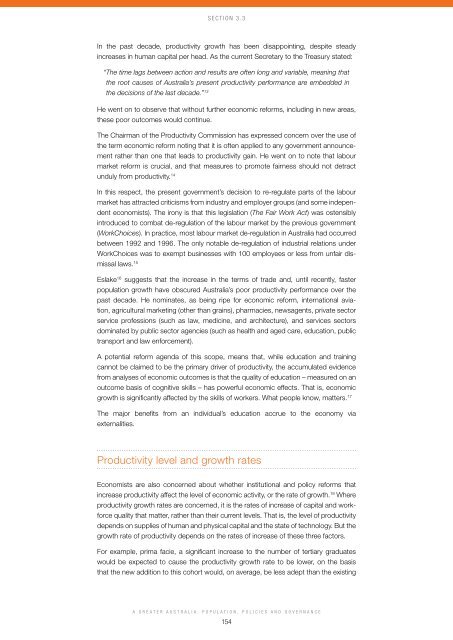A Greater Australia: Population, policies and governance - CEDA
A Greater Australia: Population, policies and governance - CEDA
A Greater Australia: Population, policies and governance - CEDA
- No tags were found...
Create successful ePaper yourself
Turn your PDF publications into a flip-book with our unique Google optimized e-Paper software.
Section 3.3In the past decade, productivity growth has been disappointing, despite steadyincreases in human capital per head. As the current Secretary to the Treasury stated:“The time lags between action <strong>and</strong> results are often long <strong>and</strong> variable, meaning thatthe root causes of <strong>Australia</strong>’s present productivity performance are embedded inthe decisions of the last decade.” 13He went on to observe that without further economic reforms, including in new areas,these poor outcomes would continue.The Chairman of the Productivity Commission has expressed concern over the use ofthe term economic reform noting that it is often applied to any government announcementrather than one that leads to productivity gain. He went on to note that labourmarket reform is crucial, <strong>and</strong> that measures to promote fairness should not detractunduly from productivity. 14In this respect, the present government’s decision to re-regulate parts of the labourmarket has attracted criticisms from industry <strong>and</strong> employer groups (<strong>and</strong> some independenteconomists). The irony is that this legislation (The Fair Work Act) was ostensiblyintroduced to combat de-regulation of the labour market by the previous government(WorkChoices). In practice, most labour market de-regulation in <strong>Australia</strong> had occurredbetween 1992 <strong>and</strong> 1996. The only notable de-regulation of industrial relations underWorkChoices was to exempt businesses with 100 employees or less from unfair dismissallaws. 15Eslake 16 suggests that the increase in the terms of trade <strong>and</strong>, until recently, fasterpopulation growth have obscured <strong>Australia</strong>’s poor productivity performance over thepast decade. He nominates, as being ripe for economic reform, international aviation,agricultural marketing (other than grains), pharmacies, newsagents, private sectorservice professions (such as law, medicine, <strong>and</strong> architecture), <strong>and</strong> services sectorsdominated by public sector agencies (such as health <strong>and</strong> aged care, education, publictransport <strong>and</strong> law enforcement).A potential reform agenda of this scope, means that, while education <strong>and</strong> trainingcannot be claimed to be the primary driver of productivity, the accumulated evidencefrom analyses of economic outcomes is that the quality of education – measured on anoutcome basis of cognitive skills – has powerful economic effects. That is, economicgrowth is significantly affected by the skills of workers. What people know, matters. 17The major benefits from an individual’s education accrue to the economy viaexternalities.Productivity level <strong>and</strong> growth ratesEconomists are also concerned about whether institutional <strong>and</strong> policy reforms thatincrease productivity affect the level of economic activity, or the rate of growth. 18 Whereproductivity growth rates are concerned, it is the rates of increase of capital <strong>and</strong> workforcequality that matter, rather than their current levels. That is, the level of productivitydepends on supplies of human <strong>and</strong> physical capital <strong>and</strong> the state of technology. But thegrowth rate of productivity depends on the rates of increase of these three factors.For example, prima facie, a significant increase to the number of tertiary graduateswould be expected to cause the productivity growth rate to be lower, on the basisthat the new addition to this cohort would, on average, be less adept than the existingA <strong>Greater</strong> <strong>Australia</strong>: <strong>Population</strong>, Policies <strong>and</strong> Governance154





